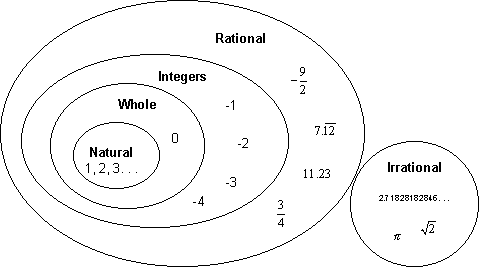What really IS a real number?
A real number is a number that belongs to the set ℝ.
The set ℝ is the set of all numbers on the number line, even the ones which you cannot exactly pinpoint(e.g. π.)
To be more precise the ℝ is comprised of the union of 4 smaller subsets.
Starting form the smallest...
N -> Natural Numbers - which is the set of natural numbers: 1, 2, 3, 4, ...., n
W -> Whole Numbers - simply the Natural Numbers + {0}: 0, 1, 2, 3, 4, ...., n
Z -> Integer Numbers - this is the Whole Numbers + {-Natural Numbers}: -n, ..., -3, -2, -1, 0, 1, 2, 3, ..., n
Q -> Rational Numbers - this is the set of all numbers that can be written as ( a / b ) where a and b belong to Z, and b is not 0: 3/4, 19/31, ... a/b
Q' -> Irrational Numbers - this is the set off all numbers that cannot be written as a fraction of any numbers belonging to Z: sqrt(2), sqrt(3), π, e, ...
This does not include numbers like 0.333333.... since it can be written as 1/3.
Below is a diagram showing the sets included in ℝ.
To get a better idea of what a real number IS, it may be useful to determine what a real number IS NOT.
To be blunt and real number is NOT and imaginary number. But what is an imaginary number?
Imaginary numbers are those written in the form:
a + bi
Where i is the imaginary unit, or sqrt(-1).
This number does exist, and is by no means 'imaginary' it is just called imaginary because we cannot represent it in our universe. It has a value, but does not have a representation. Can you show me sqrt(-1) bananas? Can you even approximate sqrt(-1) bananas?
This idea of being able to be 'represented' in our universe helps to explain what a real number is.
Some real numbers may be impossible to find their exact value, but an approximation can be made and we can perceive values such as pi as being half the distance around the unit circle. Or when we see e, the golden ratio all over nature.
This is not to say that imaginary, or complex, numbers do not exist, because they do. Some problems would be impossible to solve if it were not for the existence of imaginary numbers.
The best explanation I came across describing the relationship between Real and Complex number is that Real numbers exist on a one-dimensional line, the number line. When you add complex numbers that one-dimensional line becomes a two-dimensional plane. However we are unable to perceive this second-dimension. Just as we know time exists, and we can measure time. We still cannot perceive time with our senses. This is the case with complex numbers. We know they are there, but we cannot 'see' them.
I believe this is out of the scope of what a Real number is but if you would like to be a better understand of the further dimension of numbers: http://en.wikipedia.org/wiki/Quaternion is an explanation of the fourth-dimension of numbers using 1, i, j, k each of which are the units of their own dimensions.
So in summary a Real number is:
A number that belongs to the set ℝ.
A number that does not belong the the set C, or complex numbers.
It is a number that we can sense or perceive as having intrinsic value.
A Real number belongs to the first-dimension of the N-dimensional number space.



